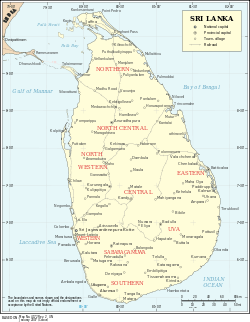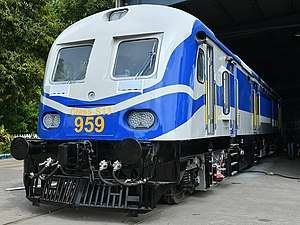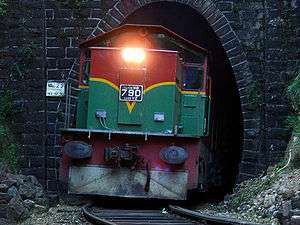Sri Lanka Railways
The Sri Lanka Railway Department (more commonly known as Sri Lanka Railways (SLR)) (Sinhala: ශ්රී ලංකා දුම්රිය සේවය Śrī Laṃkā Dumriya Sēvaya; Tamil: இலங்கை புகையிரத சேவை Ilankai Pugaiyiradha Sēvai) is Sri Lanka's railway owner and primary operator. As part of the Sri Lankan government, it is overseen by the Ministry of Transport. Founded in 1858 as the Ceylon Government Railway, it operates the nation's rail and links the capital, Colombo, with other population centres and tourist destinations.
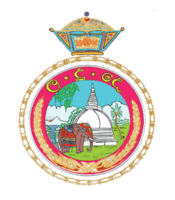 | |||||||||||||||
Native name | ශ්රී ලංකා දුම්රිය සේවය (Sinhala) இலங்கை புகையிரத சேவை (Tamil) | ||||||||||||||
|---|---|---|---|---|---|---|---|---|---|---|---|---|---|---|---|
| Government-owned corporation | |||||||||||||||
| Industry | Rail transport | ||||||||||||||
| Founded | 1858 | ||||||||||||||
| Headquarters | Colombo, Sri Lanka | ||||||||||||||
Key people | Dilantha Fernando , General Manager[1] | ||||||||||||||
| Services | Passenger railways Freight services Parcel carrier Catering and tourism services Parking lot operations Other related services | ||||||||||||||
| Revenue | LKR | ||||||||||||||
| LKR | |||||||||||||||
| LKR | |||||||||||||||
| Owner | Government of Sri Lanka (100%) | ||||||||||||||
Number of employees | |||||||||||||||
| |||||||||||||||
| Website | railway | ||||||||||||||
The Sri Lankan rail network is 1,508 km (937 mi) of 5 ft 6 in (1,676 mm) broad gauge. Some of its routes are scenic, with the Main Line passing (or crossing) waterfalls, mountains, tea estates, pine forests, bridges and peak stations.
History
Beginnings
The rail network was introduced by the British colonial government in 1864. The main reason for building a railway system in Ceylon was to transport tea and coffee from the hill country to Colombo. The service began with a 54-kilometre (34 mi) main line connecting Colombo and Ambepussa.[5] Guilford Lindsey Molesworth, the first chief engineer, became director general of the government railway. Many Ceylonese people referred to the trains as (Sinhala:අගුරු කකා වතුර බිබී කොළඹ දුවන යකඩ යකා) Anguru Kaka Wathura Bibi Colaba Duwana Yakada Yaka[6] ("coal-eating, water-drinking, metal devil which is sprinting to Colombo").
Extensions were made to the main line in 1867, 1874, 1885, 1894 and 1924, extending it to Kandy, Nawalapitiya, Nanu Oya, Bandarawela and Badulla.[7] Other lines were added to the Ceylon Railway System during its first century, including an 1880 line to Matale, the 1895 Coast Railway Line, the 1905 Northern Line, the 1914 Mannar Line, the 1919 Kelani Valley Line, the 1926 Puttalam Line and the 1928 Railway Line to Batticaloa and Trincomalee. For more than 80 years afterwards,[8] no major extensions were added to the Ceylonese rail network.
 1880 steam-powered train on the hill-country Colombo-Badulla line
1880 steam-powered train on the hill-country Colombo-Badulla line Railway lines near Colombo in 1940
Railway lines near Colombo in 1940
Golden age
The golden age of Ceylon Railways was from 1955 to 1970 under the management of B. D. Rampala, chief mechanical engineer and later general manager of the Ceylon Government Railway.[6] Emphasising punctuality and comfort, Rampala led upgrades to major railway stations outside Colombo and the rebuilding of track in the Eastern Province to facilitate heavier, faster trains. He introduced express trains (many of which had iconic names), and ensured that Ceylon's rail system was up-to-date and offered greater comfort to its passengers.[6][9]
Until 1953, Ceylon's railways used steam locomotives. During its golden age, they changed to diesel locomotives under Rampala's leadership;[9] several types of diesel locomotives were added to the fleet.
Decline
During the late 20th century, the railway began to decline; for three decades, it was neglected and poorly run.[10] The Sri Lankan economy had shifted its focus from plantation agriculture to industry, and its road network grew. With the increase in lorries and highways (a faster means of transporting goods) the amount of goods transported by rail declined, and the railways experienced heavy losses.
SLR failed to adopt technological innovations seen in other railways abroad, and problems with travel time, reliability and comfort caused it to lose much of its passenger market share. By 2011, it had a seven-percent share of the market.[6]
Rebirth
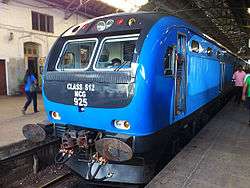
The government began a 10-year Railway Development Strategy to return the network to satisfactory condition in the early 2010s, ordering new DMUs to replace current trains.[6][10][11] The southern line, which was damaged in the 2004 tsunami, was upgraded from 2010 to 2012. Its track was upgraded to handle train speeds of 100 km/h (62 mph).[12] The northern line affected by almost three decades of war, is being rebuilt; in 2015, it was restored to Jaffna and Kankesanturai at pre-war levels.[13] The southern line is being extended from Matara to Kataragama to serve the developing city of Hambantota.[8] In 2015, track construction to Beliaththa was seriously delayed. In 2011, Sri Lanka Railways began partnerships with ExpoRail and Rajadhani Express for premium service on major routes.[14][15]
Operators
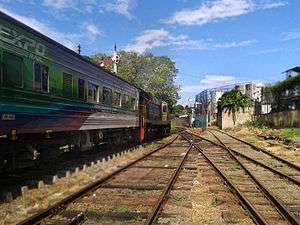
Sri Lanka Railways operates nearly all rail services in the country. A state-owned enterprise, Sri Lanka Railways operates passenger intercity and commuter rail and freight transport.
Private operators provide some services with Sri Lanka Railways' equipment and infrastructure. The Viceroy Special, a heritage train with a preserved steam locomotive, is operated by J. F. Tours & Travels.[16][17] Airport & Aviation Services Limited operates the Airport Express between Colombo's Secretariat Station and Bandaranaike International Airport.
On 6 October 2011, Expolanka introduced its ExpoRail premium service;[18][19] the Blue Line Company introduced a competing service, the Rajadhani Express, the same day. ExpoRail and Rajadhani operate a premium section on trains operated by Sri Lanka Railways.[18][20] Colombo's tram system was operated by the Colombo Electric Tram Car and Lighting Company before it was taken over by the municipal council and shut down.
Rolling stock
Sri Lanka Railways' locomotives are primarily diesel. Steam locomotives, in regular service until the 1950s, are used only on heritage trains such as the Viceroy Special.[9][21]
The first locomotives pulled trains during the 1860s on the original 54-km main line connecting Colombo and Ambepussa.[5] Sri Lanka Railways converted to diesel locomotives in 1953,[9] and several types of diesel locomotives were added to the fleet. Although Sri Lanka did not have commercially-operating electric locomotives or trainsets in 2011, electrification has been proposed to improve energy efficiency and sustainability.[22]
Most passenger coaches are from the Romanian Astra Rail Industries[23][24] or the Chinese CSR Corporation. On most lines, service is being upgraded with new, long-haul diesel multiple units from CSR Corporation and India's RITES.[10][11][25]
Network
The 1,508-kilometre (937 mi) Sri Lankan railway network is 5 ft 6 in (1,676 mm) broad gauge.[9] All service is diesel-powered.[26] The network is divided into three operating regions based in Colombo, Anuradhapura and Nawalapitiya.[27][28] The railway is currently modernising and extending the Coast Line to facilitate faster trains and improved efficiency.[29]
Electrification
Although electrification was first proposed in 1928, the Cabinet did not approve the electrification of suburban railways until 2015. Electrification of the Panadura-Veyangoda line is proposed in phase one of the Western Region Megapolis plan with a soft loan from the Asian Development Bank.[30][31][32]
A contract has been signed by Malaysia's Airport Express Air and Rail Company and the government of Sri Lanka for new electric rail line between Negombo and Colombo. The project is expected to be completed by 2018.[33] Electrification of the busiest sections of the network was proposed several times to improve energy efficiency and sustainability. Around 1998, the Institution of Engineers, Sri Lanka (IESL) submitted recommendations for railway electrification. Although they were approved by the cabinet, they were not implemented. IESL made new proposals for electrification in 2008 and 2010, but no work was done because the voltage systems were undefined. System electrification is favoured by the IESL to reduce pollution, increase passenger comfort and lessen travel time.[34][6]
Sri Lanka Railways is planning to electrify the 120-kilometre (75 mi) Colombo commuter-rail system from Veyangoda to Maradana, Maradana to Kaluthara and Ragama to Negombo, but their voltage systems are unknown. Fifteen electric multiple units will be imported for commuter service.[35]
Signalling
Much of the network uses a lock-and-block signaling system. During the mid-twentieth century, the busiest sectors (around Colombo) were upgraded to electronic signalling connected to a CTC control panel at the Maradana railway station.[9]
In 2011, a project to add electronic signalling to the northern lines began. Track between Anuradhapura, Kankesanturai, and Talaimannar would have electronic signalling with centralised traffic control, using an interlocking colour-light system with electrically-operated points and a track-detection system. Level crossings would be connected to the signalling system, ensuring safety.[36]
After the 2011 Alawwa rail accident, SLR began installing a GPS-based train-protection system on its entire fleet. The system warns a train driver of a possible collision in time to manually stop the train. The fleet can also be monitored by a central control room with the system. A trial run was conducted in early November 2011 with ten trains.[37][38]
Routes
Major population centres and tourist destinations are connected by rail. Service began in 1864 with the construction of the Main Line from Colombo to Ambepussa, 54 kilometres (34 mi) east, and the first train ran on 27 December 1864. The line was officially opened to traffic on 2 October 1865. The Main Line was extended in stages, with service to Kandy in 1867, to Nawalapitiya in 1874, to Nanu-Oya in 1885, to Bandarawela in 1894, and to Badulla in 1924.[39] Other lines were completed to link the country: the Matale Line in 1880, the Coast Line in 1895, the Northern Line in 1905, the Mannar Line in 1914, the Kelani Valley Line in 1919, the Puttalam Line in 1926, and the Batticaloa and Trincomalee Lines in 1928.[40]
Main Line
The Main Line starts from Colombo and runs east and north past the developing centres of Ragama, Ganemulla Gampaha, Veyangoda, Mirigama, Ambepussa and Polgahawela. At Rambukkana, the line begins a steep climb into the hills. Between Balana and Kadugannawa the track runs along the edge of sheer cliffs, allowing passengers a view of Batalegala.
The Main Line then continues climbing through tea country, connecting market centers at Gampola, Nawalapitiya and Hatton before reaching Nanu-Oya. This is the connection to the former colonial resort of Nuwara Eliya, still visited for its temperate climate, classic hotels and British-style gardens. The Main Line reaches its summit at Pattipola, 6,226 feet (1,898 m) above sea level, before descending past Bandarawela to Badulla. Passengers can view tea gardens, mountains, valleys and waterfalls.
Coastal line
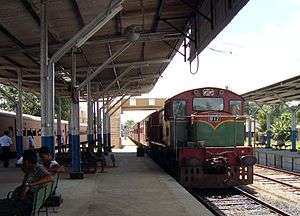
The coastal line runs south from Colombo, following the Indian Ocean, with views of tropical beaches and coconut palm trees. It links the regional centres of Moratuwa, Panadura and Kalutara South, and beach resorts at Aluthgama, Ambalangoda and Hikkaduwa. The line continues past Galle (known for its historic, well-preserved Dutch fort) before terminating at Beliatta.
From 1895 to 2013, the line terminated at Matara.[41] In 2013–2019, the China National Machinery Import and Export Corporation extended the line to Beliatta in Phase 1 of the Southern Railway project.[42] This was the first new railway built in Sri Lanka since independence from Great Britain in 1948.[43] Phase 2 will serve Magampura Mahinda Rajapaksa Port in Hambantota, and Phase 3 will reach Kataragama. The latter phases have not yet begun construction as of April 2019.[42]
Puttalam line
The Puttalam line branches off the Main Line at Ragama junction, extending north past Kandana Ja-Ela, Seeduwa, Katunayake (International Airport) and Negombo (a regional tourist destination and a major commercial centre). It connects northwestern Sri Lanka, reaching Negombo Kochikade, Waikkala, Luniwila (and the National Coconut Research Center), Nattandiya, Madampe, Chilaw, Bangadeniya, Mundel and Puttalam.
The line also links other market towns and fishing villages. Passenger service ends at the Noor Nagar station, just north of Puttalam; beyond that, the tracks are used by Holcim trains to haul cement.
Kelani Valley line
The Kelani Valley line extends from Colombo-Maradana east to Avissawella. Originally a narrow-gauge line, it was converted to 5 ft 6 in (1,676 mm) broad gauge between 1991 and 1997. The line connects the suburbs of Colombo in the Colombo District with the city.
Matale line
The Matale line branches off the Main Line at Peradeniya Junction, near the Peradeniya Botanical Gardens. It runs to Kandy, home of the Sri Dalada Maligawa (which houses the relic of the tooth of the Buddha), before descending to Matale.
Northern line
.jpg)
The Northern line branches north from the Main Line at Polgahawela, passing Kurunegala—capital of North Western Province—before continuing to the cultural center of Anuradhapura (the island's capital around the 4th century BCE, and home to many religious and archaeological sites). Service has been extended to the line's terminus at Kankesanthurai on the Jaffna peninsula, past Kilinochchi.[44]
Mannar line
The Mannar line branches westward from the northern line at Medawachchiya, passing Madhu Road—location of the Shrine of Our Lady of Madhu—and continuing to Mannar Island (home of the district capital and terminus of the former Talaimannar line).
Batticaloa line
The Batticaloa line branches eastward from the northern line at Maho to Polonnaruwa, site of an 11th-century capital and home to a number of historic monuments. The line continues to the city of Batticaloa.[45]
Trincomalee line
The Trincomalee line branches north and east from the Batticaloa line at Gal-Oya Junction and extends to Trincomalee.
Mihintale line
The Mihintale line is a short branch line which connects Mihintale (home of the Mihintale Temple, where Thera Mahinda—who brought Buddhism to Sri Lanka—arrived) with Anuradhapura, the capital of Sri Lanka for over 100 years, via the northern line. It branches off the latter at Mihintale Junction and runs eastward to Mihintale (the line's only stations).
Intercity network
The intercity network radiates from Colombo, connecting most major population and industrial centres with passenger and freight service.[28] It includes hubs at Colombo Fort and Maradana.
Passenger service
Sri Lanka Railways operates intercity service connecting major population centres and commuter rail, serving Colombo commuters.[46] The railway also transports freight. Most intercity trains have a number of classes:[47]
- 1st class sleeper, with sleeping berths, is available on a few overnight trains.
- 1st class observation car is available on some day trains, primarily on the Main Line. Normally at the rear of the train, it is occasionally behind the locomotive.
- 1st class air-conditioned[47] seats are available on some intercity express trains between Colombo and Vavunia and Colombo and Batticaloa. They are also available on the main-line Udarata Manike and Podi Manike trains.
- 2nd class seats, available on all intercity trains, are unreserved or reserved.
- 3rd class, available on most trains, has basic facilities.
- Rajadhani Express and ExpoRail provide premium service on many intercity trains. Ticket prices for the air-conditioned compartments are typically higher than SLR's first-class tickets and include tea, snacks and meals. Currently, these trains do not operate.
Commuter trains serve the busiest portions of the railways in Colombo and its suburbs.[48] Most commuter trains are diesel multiple units and lack the three-class configuration of intercity service.[46] Commuter trains, which alleviate rush-hour congestion on city roads, can be crowded. Electrification of the commuter-rail network has been proposed to improve energy efficiency and sustainability.[22]
Train types
- Intercity express: Among the fastest trains, with few stops (have to get special tickets for these; ticket prices are higher than normal ones)
- Night mail: Night-time express trains with freight transport
- Express: Link Colombo and major transport hubs
- Suburban: Stop at each station on the route
Services by routes
SLR divides its network into three operating regions, based in Colombo Maradana, Nawalapitya and Anuradhapura.[49] Nine lines make up the railway network. Several services were named during the 1950s.
| Route | Major trains | |
|---|---|---|
| Main Line | Colombo Fort to Nawalapitya, Nanu Oya, and Badulla | Udarata Menike, Podi Menike, Tikiri Menike' (only to Hatton )', Senkadagala Menike (to Kandy), Colombo - Badulla Night Mail Train,Denuwara Menike |
| Matale line | Peradeniya Junction to Kandy and Matale | |
| Route | Major trains | |
|---|---|---|
| Northern line | Polgahawela Junction to Kurunegala, Anuradhapura, Jaffna and Kankesanthurai | Yal Devi, Rajarata Rejini Jaffna night mail,Jaffna ac intercity |
| Mannar line | Medawachchi Junction to Mannar and Talaimannar | |
| Batticaloa line | Maho Junction to Polonnaruwa and Batticaloa | Udaya Devi, Meena Gaya,Pulathisi ice |
| Trincomalee line | Gal Oya Junction to Kantale and Trincomalee | |
| Route | Major trains | |
|---|---|---|
| Coastal line | Colombo Fort to Galle, Matara and Beliatta; under construction to Beliatta to Kataragama | Ruhunu Kumari, Samudra Devi, Galu Kumari, Sagarika, Rajarata RejiniDakshina intercity |
| Kelani Valley line | Colombo Maradana to Avissawella | |
| Puttalam line | Ragama to Puttalam | Muthu Kumari, Puttalam mixed train ,Puttalam express train ,Chilaw express |
Links to India
A proposal to link the railways of Sri Lanka and India never materialised. However, a combined train-ferry-train service known as Boat Mail connected Colombo with Chennai for much of the twentieth century.[50]
A 35 km (22 mi) bridge linking the countries was proposed in 1894, by the consultant engineer for railways in Madras (Chennai). The proposal was seriously considered, and a technical blueprint and cost analysis were made. By 1914, the Mannar line was built to connect Talaimannar on Mannar Island to the Sri Lankan mainland, and the Indian rail network was extended to Dhanushkodi. However, a bridge linking them was not built.[50]
Ferry service connecting the railheads at Talaimannar and Dhanushkodi lasted until the 1960s, when a cyclone destroyed the pier and rail line at Dhanushkodi. The ferry service resumed from the Indian terminus at Rameshwaram, ending due to the Sri Lankan Civil War.[50] A rail bridge (or tunnel) was proposed again during the 2000s, highlighting the benefits of connecting the ports of Colombo and Trincomalee with Chennai.[50]
Urban rail
Suburban Rail

Commuter rail service connects Colombo to its suburbs, helping alleviate rush-hour congestion on city roads. Local commuter trains use the same tracks as the intercity lines. Colombo's commuter-rail network is 100 kilometres (62 mi) of track from Panadura to Polgahawela via the Fort and Maradana stations. The route is multi-tracked to provide rush-hour service.[51] Electrification of the commuter rail network has been proposed, to improve energy efficiency and sustainability.[52][34]
Metro
A 1,435 mm (4 ft 8 1⁄2 in) standard gauge metro system was proposed in the 2010s to give commuters in Colombo a clean, environmentally-friendly transit option. The metro would reduce the load on the overcrowded commuter-rail system and alleviate congestion on major roads.[53] A consortium of three companies is conducting feasibility studies on the project.[54]
Light Rail
The Colombo Light Rail has been funded to $1.25 billion.[55]
Railbus
In areas without significant demand for commuter trains (such as the Eastern province), railbuses connect towns and cities. Railbus service from Batticaloa and Trincomalee allows passengers to travel between the cities with fewer delays.[56]
Tram
A tram system operated in Colombo from 1899 to 1960. It was operated by Colombo Electric Tramways and Lighting Co. Ltd., before being officially transferred to the Colombo Municipal Council on 31 August 1944.[57]
High-Speed Rail
High Speed Railway Corporation (Pvt.) Ltd (HSRC) has attempted to introduce mag-lev technology to the island, with a line connecting Negombo to Colombo 3.[58]
Issues
Discrimination towards locals
In February 2017, Sri Lanka's Sunday Times criticized SLR for racist washroom facilities at stations. Foreigners may use clean washrooms, but Sri Lankan citizens are forced to use poorly-maintained and often-unsanitary washrooms. Signage clearly distinguish "foreigners' toilets" from other facilities. According to the Sunday Times article, foreigners' facilities were at the Colombo Fort, Mount Lavinia, Badulla, Hikkaduwa and Panadura stations. Transport Ministry secretary Nihal Somaweera said that foreign-tourist toilets were upgraded with funding from the Tourism Ministry. The article described the mindset of SLR's leadership as a legacy of the colonial era.[59]
Accidents
- 18 March 1964 - A train derailed at high speed, killing over 60 people near Mirigama.
- 19 January 1985 - LTTE bombed the Yal Devi killing 11 civilians.
- 24 July 1996 - LTTE bombed a train, resulting in 70 civilian deaths at Dehiwala.
- 19 August 2001 - A train derailed because of high speed and overcrowding, killing 46 between Alawwa and Rambukkana.
- January 2002 - An intercity express en route to Colombo from Kandy derailed near Rambukkana due to a brake malfunction, killing more than 15.
- 13 June 2002 – A train derailed entering the Alawwa railway station, killing 14.
- 26 December 2004 – 2004 tsunami rail disaster – At Peraliya, over 1,700 died in the world's biggest rail disaster by death toll when a train was overwhelmed by the 2004 Indian Ocean earthquake and tsunami.
- 26 April 2005 (Polgahawela level crossing accident) – A bus trying to pass another bus at a level crossing in Yangalmodara (near Polgahawela) was struck by a train; 37 bus passengers died.
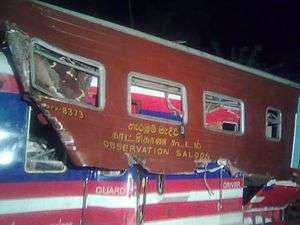
- 17 September 2011 – An S11 passenger train struck the stopped Colombo-Kandy Udarata Manike at the Alawwa railway station. Five people were killed and over 30 injured.[60]
- 17 May 2012 - After a train struck a stopped train, two trains collided between the Wandurawa and Keenawala stations in Veyangoda.[61]
- 30 April 2014 - A northbound intercity express collided with the Colombo-bound Rajarata Rajina at Pothuhera, injuring 68 passengers.[62]
A number of other accidents have occurred, including collisions with elephants in the north-central region. Other accidents occur at unsecured level crossings with road traffic. Of Sri Lanka's 1,684 crossings, only 527 are secure.
In an attempt to prevent collisions, SLR has begun installing a GPS-based train-protection system. The system will warn drivers of a possible collision in time to avoid it.[37][38]
Cultural impact
Sri Lanka Railways has become part of popular culture, with references in books and TV shows. A band, Neville Fernando & Los Caballeros, performed a song entitled "Samuduru Devi" during the 1960s about the passenger train. The railway influences how suburban living is perceived, The rail lines in the hill country are promoted to tourists.
See also
- Rail transport in Sri Lanka
- List of railway stations in Sri Lanka
- Ceylon Railway Engineer Corps
- National railway museum, Kadugannawa
References
- "Head of Organisation". Sri lanka Railways. Retrieved 15 January 2017.
- "Performance Report - 2016: Department of Sri Lanka Railway" (PDF). parliament.lk. The Parliament of Sri Lanka. Retrieved 1 December 2019.
- "Sri Lanka Railways runs at a massive loss exceeding 94 per cent of income". www.lankanewsweb.net. Lankanewsweb.net. Retrieved 2 December 2019.
- "Sri Lanka to get 1st electric rail track". www.energy.economictimes.indiatime.com. Energy World. Retrieved 27 February 2020.
- "Ceylon Railway Enthusiasts Circle (CREC)/SLRF". Sri Lanka Railway 145th Anniversary Trip. 2 January 2010.
- Farzandh, Jiffry (19 December 2011). "B. D. Rampala - an engineer par excellence". Ceylon Daily News. Archived from the original on 13 January 2012. Retrieved 3 January 2012.
- "Sunday Observer". Cameos of the past: First train on line to Badulla from Colombo. 19 July 2010. Archived from the original on 3 March 2016.
- "Construction of Matara-Kataragama railway line in Southern Sri Lanka". ColomboPage. 6 April 2010.
- "The Island". Rampala regime in the local Railway History. 19 July 2010.
- "Dailynews". Power sets to steam long distance travel. 3 September 2010. Archived from the original on 8 March 2012.
- "Dailynews". Railway gets new power sets from China. 23 April 2010. Archived from the original on 8 March 2012.
- Dissanayake, Ridma (11 April 2012). "Southern railway line re-opens today". Ceylon Daily News. Archived from the original on 13 April 2012. Retrieved 11 September 2012.
- "Lanka Business Online". Sri Lanka gives northern rail rebuilding deal to India’s IRCON. 18 August 2010. Archived from the original on 4 October 2011.
- "Luxury Rail". Lanka Business Today. 26 February 2012. Archived from the original on 2 March 2012. Retrieved 28 February 2012.
- "Sri Lankan railway introduces luxury class Services on Colombo -Kandy rails". News.lk. 7 November 2011. Archived from the original on 4 April 2012. Retrieved 28 February 2012.
- Viceroy Vintage Train Tours
- Weerasuriya, Sanath. "'Viceroy Special' rolls on the track for 25 years". The Sunday Times. Retrieved 14 December 2011.
- "Sri Lankan railway introduces luxury class Services on Colombo-Kandy rails". news.lk. 7 October 2011. Archived from the original on 4 April 2012.
- "EXPORAIL". Archived from the original on 5 October 2011. Retrieved 5 October 2011.
- "Daily Mirror". Expo Rail: Wonder on the track. 3 October 2011. Archived from the original on 9 May 2012.
- http://www.infolanka.com/org/mrail/locos1.html
- "Daily News". IESL proposes railway electrification project. 25 December 2010. Archived from the original on 8 March 2012.
- "Daily News". Railway to buy more locos, carriages. 12 May 2007. Archived from the original on 18 February 2013.
- http://www.infolanka.com/org/mrail/slrails.html The Railways of Sri Lanka (Ceylon)
- "ColomboPage". India hands over new power sets for Sri Lanka's Southern Railway Line. 11 March 2011.
- http://www.infolanka.com/org/mrail/slrails.html
- "Our Network". Sri Lanka Railways. Archived from the original on 3 December 2011. Retrieved 6 February 2012.
- "Lanka Business Online". Rail Move: Sri Lanka revives railway link to port. 20 July 2011. Archived from the original on 6 May 2012. Retrieved 21 July 2011.
- "Dailymirror". No trains between Galle and Kalutara South. 23 April 2011. Archived from the original on 4 October 2011.
- "Panadura-Veyangoda railway to be electrified". www.sundayobserver.lk. Archived from the original on 18 May 2016. Retrieved 15 May 2016.
- "Projects identification Document V3" (PDF).
- "Western Region Megapolis From Island To Continent | The Sunday Leader". Retrieved 15 May 2016.
- "Agreement signed to start Sri Lanka's first elect train system – Video | Adaderana Biz English | Sri Lanka Business News". bizenglish.adaderana.lk. Retrieved 20 September 2015.
- "Daily News". IESL proposes railway electrification project. 25 December 2010. Archived from the original on 8 March 2012.
- "Future Plans". Sri Lanka Railways. Retrieved 11 February 2012.
- "Asian Tribune". Agreement for supply and installation of Signaling & Telecommunication system for Northern railway network. 18 August 2011.
- "Daily Mirror". SLR to equip fleet with modern safety devices. 21 November 2011.
- "ColomboPage". Sri Lanka Railways installs new equipment to prevent accidents. 26 October 2011.
- "Sunday Observer". Cameos of the past: First train on line to Badulla from Colombo. 19 July 2010. Archived from the original on 3 March 2016.
- http://www.infolanka.com/org/mrail/rroutes.html The Rail Routes of Sri Lanka
- Wright, Arnold, ed. (1907). Twentieth Century Impressions of Ceylon. London. p. 196.
In 1895 the South Coast line was opened to its present terminus at Matara ...
- "Sri Lanka opens first phase of China-financed Southern Railway line". Railway Gazette. 9 April 2019.
- Patranobis, Sutirtho (9 April 2019). "Under Belt and Road Initiative, China builds rail line in Sri Lanka, a first since 1948". Hindustan Times.
- "Archived copy". Archived from the original on 22 September 2013. Retrieved 22 September 2013.CS1 maint: archived copy as title (link)
- "TamilNet". Trains to Batticaloa back on track. 12 April 2003.
- "The Island". Samudra Devi in a Tangle of Love!. 12 July 2009. Archived from the original on 13 September 2011.
- "A beginner's guide to Train travel in Sri Lanka ..."
- "The Island". Railway Electrification: Let us Start, at least now. 27 March 2010. Archived from the original on 5 July 2010.
- "Our Network". Sri Lanka Railways. Archived from the original on 3 December 2011. Retrieved 9 March 2012.
- http://infolanka.asia/sri-lanka/transport/the-indo-lanka-land-bridge-reviving-the-proposal The Indo-Lanka Land bridge: Reviving the Proposal
- http://www.unescap.org/ttdw/Publications/TIS_pubs/tarsc_fulltext_1980.pdf Archived 17 July 2011 at the Wayback Machine Economic and Social Commission for Asia and the Pacific. Development of the Trans-Asian Railway: Trans-Asian Railway in the Southern Corridor of Asia-Europe Routes. 1999.
- "The Island". Railway Electrification: Let us Start, at least now. 27 March 2010. Archived from the original on 5 July 2010.
- "The Morning Leader". Opinion – Metro long overdue for Colombo. 27 March 2010. Archived from the original on 24 January 2010. Retrieved 19 July 2010.
- "Daily News". Foreign-funded Colombo Metro feasibility study begins. 6 December 2006. Archived from the original on 13 January 2012. Retrieved 19 July 2010.
- "Light Rail project to kick off in December 2018". www.ft.lk. Retrieved 20 December 2018.
- "The Island". Eastern Province railbus project commences. 30 July 2009.
- "Colombo Electric Tramways and Lighting Co. Ltd (appellant), and Commissioner of Inland Revenue (respondent)". Lawnet: Ministry of Justice. p. 313. Retrieved 29 May 2019.
- "High Speed Railway Corp. gears to introduce maglev technology to Sri Lanka". www.dailymirror.lk. Retrieved 18 December 2018.
- Warakapitiya, Kasun (5 February 2017). "Passengers hold their noses at racist, incompetent railway". Sri Lanka Sunday Times. Retrieved 26 March 2017.
- "Death toll in Alawwa train accident rises to 5". 18 September 2011.
- "News First". Trains collide in Veyangoda. 18 May 2012.
- "68 injured in train accident". Daily Mirror. Retrieved 2 May 2014.
Further reading
- Winchester, Clarence, ed. (1936), "Rail transport in Ceylon", Railway Wonders of the World, pp. 1100–1105 illustrated description of the railways of Ceylon in the 1930s
External links
| Wikimedia Commons has media related to Sri Lanka Railways. |
- Sri Lanka Railways Official Site
- Ministry of Transport
- Sri Lanka Railways Timetables
- Sri Lanka Railway mainland routes timetables from "Seat61" (this is not updated)
- Locomotives of the SRI LANKA RAILWAY (M2, Jaffna Rail pictures)
- Sri Lankan Diesel Locomotives Page
- Kelani Valley Railway-කැලණිවැලි දුම්රිය fb page
- BRUSH BAGNALL SRI LANKA Restoration web site
- Sri Lanka Railways Photo Collection
- Two Unforgettable Railway Accidents
- ෴අඟුරු නොකා වතුර නොබී කොළඹ දුවන යකඩ යකා෴
- An essay about taking the train from Colombo to Kandy
- Locomotives Of Sri Lanka
